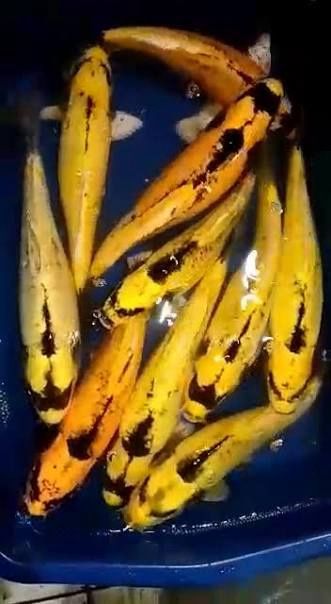Banana Koi (10-15cm)
Banana Koi (Yamabuki Ogon) Care Guide
Common Names: Banana Koi, Yamabuki Ogon
Scientific Name: Cyprinus rubrofuscus (ornamental variety)
Origin: Japan (domesticated variety)
Coloration: Solid metallic yellow or gold
Size: Up to 60–90 cm (24–36 inches)
Lifespan: 25–35 years (some live longer with proper care)
Temperament: Peaceful, social
Difficulty: Easy to Moderate
✅ Pond/Tank Requirements
-
Minimum Pond Size: 1,000 liters for juveniles, 4,000+ liters for adults
-
Depth: At least 1 meter (especially in colder climates)
-
Temperature: 10–25°C (can survive lower, but growth slows)
-
pH: 6.8–8.2
-
Water Hardness: Moderate to hard
-
Filtration: Strong biological and mechanical filtration is essential
-
Oxygenation: Required — use air stones or waterfalls
While Koi can temporarily be kept in large indoor aquariums as juveniles, they’re best suited for outdoor ponds due to their size and activity level.
️ Diet
Banana Koi are omnivores and have hearty appetites.
Feed them:
-
High-quality koi pellets
-
Leafy greens (lettuce, spinach)
-
Fruits (orange slices, watermelon)
-
Frozen or live foods (earthworms, bloodworms, brine shrimp)
-
Occasional treats: rice or cooked peas
Tip: Don’t overfeed! Uneaten food can quickly pollute pond water. In cold temperatures (below 10°C), their metabolism slows and feeding should stop.
Behavior and Tank Mates
-
Very peaceful and social fish
-
Enjoy being around other koi and can even recognize their keepers
-
Best kept in groups with other koi or similar-sized pond fish (like goldfish)
-
Not suitable for small community aquariums due to their eventual size
They may dig in substrate, so rooted pond plants should be protected or kept in pots.
Breeding
-
Breeding occurs in spring when water warms up
-
Males chase females around the pond, prompting them to lay eggs on plants or spawning mats
-
Eggs hatch in about 4–7 days
-
Adults may eat eggs or fry—use a separate nursery area if raising fry
Interesting Fact
The Banana Koi’s proper name, Yamabuki Ogon, translates roughly to “gold mountain metallic” in Japanese. This variety is prized for its solid, bright metallic yellow color and is considered a symbol of wealth and prosperity in Japanese koi culture. In Japan, some koi farms sell high-grade Yamabuki Ogon for thousands of dollars each!

